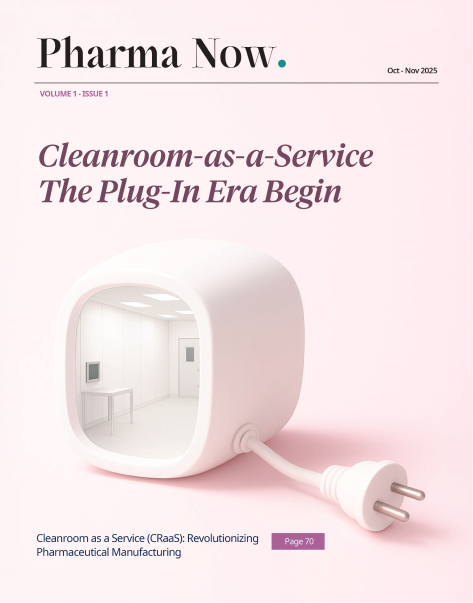by Ravindra Warang
7 minutes
Cleanroom as a Service (CRaaS): Revolutionizing Pharmaceutical Manufacturing
From Cover Story | Pg 70

Pharma innovation isn’t just about new molecules or cutting-edge biologics anymore—it’s about how we make them. Today, speed, flexibility, and compliance are just as critical as efficacy, and that’s where Cleanroom as a Service (CRaaS) comes in. Imagine accessing a fully qualified, regulatory-ready cleanroom without building it from scratch or carrying the heavy operational burden—that’s the promise CRaaS delivers. Having spent years navigating cleanroom design, validation, and regulatory expectations, I can tell you: this isn’t just a convenience—it’s a strategic shift that’s changing the way pharma manufactures tomorrow’s medicines.
Why CRaaS is Transformative?
Building a traditional cleanroom is time-consuming and capital-intensive. From design and construction to qualification, validation, and routine maintenance, it can take 12–24 months before you’re even ready to start production. Beyond that, the ongoing operational costs—HVAC monitoring, environmental sampling, gowning protocols, and cleaning—can eat into budgets quickly.
CRaaS flips this model. By providing ready-to-use, fully compliant cleanrooms on a subscription or pay-per-use basis, pharma companies can:
- Speed up time-to-market: Skip months of construction and validation—start production almost immediately.
- Ensure regulatory compliance: Providers operate under GMP, ISO 14644, and Annex 1 standards, with environmental monitoring, documentation, and audits handled by experts.
- Control costs: Convert a major capital expense into a flexible operational cost, freeing up resources for R&D and innovation.
- Scale with agility: Expand or reduce capacity based on product demand or new clinical batches without over-investing.
What Pharma Companies Should Consider
Not all CRaaS providers are created equal. When choosing a partner, consider:
- Regulatory credentials: Confirm GMP, Annex 1, and ISO compliance for your product type—sterile injectables, biologics, or personalized therapies.
- Operational transparency: Look for real-time monitoring dashboards, complete documentation, and clear SOPs.
- Customization: Check that airflow, temperature/humidity controls, and containment options meet your process needs.
- Data ownership: Ensure you can access all environmental monitoring and batch records for audits or inspections.
Case Studies
1. Germfree’s Mobile BSL-2 cGMP Cleanroom for Monoclonal Antibody Production
In less than three weeks, Germfree delivered a mobile BSL-2 cGMP cleanroom for phase 1 clinical trials of a new monoclonal antibody product. This rapid deployment enabled the company to meet urgent production timelines without the delays associated with traditional cleanroom construction. The facility was designed for repurposing, showcasing the flexibility inherent in CRaaS solutions.
2. Mecart’s Modular Cleanrooms for Biopharmaceutical Applications
Mecart provided modular cleanroom solutions for various biopharmaceutical applications, including sterile compounding and vaccine manufacturing. These cleanrooms were designed to meet stringent regulatory standards and could be easily expanded or reconfigured as production needs evolved, highlighting the scalability and adaptability of CRaaS offerings.
3. Angstrom Technology’s Custom Cleanroom Solutions
Angstrom Technology collaborated with pharmaceutical companies to design and install custom cleanrooms tailored to specific production requirements. Their approach emphasizes the importance of bespoke solutions within the CRaaS model, ensuring that each cleanroom meets the unique needs of the client while adhering to regulatory standards.
CRaaS Advantages: Cost, Compliance, and Capacity at Scale
Cost Savings
Traditional cleanroom construction can be a major drain on resources. Building a fixed facility can cost between $1 million and $2.5 million and take over a year to complete. By contrast, Cleanroom as a Service (CRaaS) dramatically reduces both capital outlay and timelines. For example, Germfree delivered a fully qualified BSL-2 cGMP cleanroom in under 3 weeks for a pharmaceutical client’s Phase I trial, compared to the 12–18 months typical of conventional builds. This kind of acceleration allows companies to redirect funds into R&D, clinical trials, and commercialization instead of tying them up in bricks and mortar.
Regulatory Compliance
Maintaining inspection-ready facilities is one of the most resource-intensive aspects of sterile manufacturing. CRaaS providers take on this responsibility by ensuring facilities comply with GMP, ISO 14644, and Annex 1 standards. For instance, Germfree’s mobile advanced therapy cleanrooms for NIH Bethesda were designed with integrated environmental monitoring and validated ISO 7/8 suites, keeping them aligned with FDA and EMA expectations. Outsourcing compliance to experts reduces the risk of non-conformance, costly rework, or regulatory delays, giving companies confidence that their operations will stand up to audits.
Scalability
Demand in pharma is rarely static—whether driven by seasonal vaccines, advanced therapies, or emergency response. CRaaS solutions are built to adapt. Their modular nature means capacity can be scaled up or down based on demand, without long-term sunk costs. A striking example comes from Mecart, which delivered over 14,000 square feet of modular cleanrooms for a vaccine research center in under 10 months. Instead of waiting years for permanent infrastructure, companies can quickly add new suites or reduce capacity when demand levels off—an agility that translates directly into competitive advantage.
How CRaaS Fits into the Future of Pharma
The pharmaceutical industry is undergoing a paradigm shift where flexibility, efficiency, and compliance are equally important as innovation. Cleanroom-as-a-Service (CRaaS) not only addresses current operational challenges but also positions itself as a cornerstone for the future of pharma.
1. Outsourcing & Contract Manufacturing
The rise of biotech startups and small to mid-sized pharma companies has redefined the need for infrastructure. These players often lack the capital to invest in multimillion-dollar cleanroom facilities but still require GMP-compliant spaces to conduct R&D, clinical trials, and small-batch production. CRaaS bridges this gap by offering plug-and-play cleanrooms, ensuring startups can focus resources on drug development and IP creation rather than infrastructure. According to Pharma Intelligence (2024), over 45% of early-stage biotech firms now rely on outsourced GMP facilities to accelerate time-to-market.
2. Agile Manufacturing
The demand for flexible, small-scale production is rapidly growing, especially for personalized medicines, cell & gene therapies, and niche biologics. Unlike traditional cleanroom setups that are rigid and capital-heavy, CRaaS allows for rapid deployment of cleanroom modules, enabling companies to quickly scale up or scale down batch production based on demand. For example, in clinical trial stages, where batch sizes are small but timelines are tight, CRaaS eliminates delays in facility readiness. This agility is particularly crucial during seasonal spikes, such as vaccine production, where responsiveness can determine market leadership.
3. Digital Integration
The pharma future is undeniably data-driven, and CRaaS providers are aligning with this vision. Leading service providers now embed IoT sensors, environmental monitoring systems, and predictive analytics tools directly into their cleanroom infrastructure. This enables real-time visibility of critical parameters like air quality, temperature, and particulate counts, accessible via cloud-based dashboards. With integrated 21 CFR Part 11-compliant electronic records, companies can streamline audits and regulatory submissions. Moreover, predictive analytics helps in anticipating equipment failures or contamination risks before they disrupt operations, driving both cost savings and compliance.
Lessons from the Field: Making CRaaS Work in Pharma
From my experience collaborating with pharmaceutical leaders across both large-scale manufacturers and emerging biotech firms, I’ve observed that the most successful Cleanroom-as-a-Service (CRaaS) engagements are built on three non-negotiable pillars:
1. Aligned Compliance Standards
Regulatory alignment is not just a checkbox—it’s the foundation of trust between client and provider. For CRaaS to be truly effective, the provider’s standard operating procedures (SOPs), environmental monitoring (EM) programs, and audit preparedness must be designed to mirror, or better yet, integrate seamlessly with the client’s existing quality management systems (QMS). This ensures that every activity—from particle monitoring to deviation management—meets the standards expected in regulatory inspections. In practice, I’ve seen pharma companies succeed when they treat the CRaaS provider as an extension of their own QA team, conducting joint mock audits, shared training sessions, and harmonized documentation practices.
2. Process Compatibility
No two drug products are alike, and cleanroom conditions must reflect this reality. While CRaaS offers a standardized infrastructure, the technical fit with the client’s production process determines long-term success. This includes matching the provider’s airflow dynamics, gowning procedures, material/personnel flow, and environmental control measures with the precise requirements of the product—whether it’s a sterile injectable, biologic therapy, or advanced cell and gene therapy. For example, a client developing viral vectors may require Class B/C background with uni-directional airflow and strict segregation of high-risk operations. A mismatch here can lead not only to compliance risks but also to operational inefficiencies and costly delays in validation.
3. Collaborative Oversight
Perhaps the most overlooked yet critical factor is governance and shared responsibility. Successful CRaaS partnerships thrive when the client assigns dedicated QA/QC personnel to oversee operations within the outsourced cleanroom. This joint oversight ensures that critical processes—such as batch record reviews, environmental excursions, and regulatory submissions—are managed with full transparency. I’ve seen projects fail when clients took a hands-off approach, relying entirely on providers. By contrast, when clients embed a collaborative oversight model, regulatory inspections often proceed more smoothly because auditors can see a clear line of accountability and integrated quality culture between both parties.
Risks and Mitigation
While CRaaS offers clear advantages, organizations must weigh certain risks:
- Shared Facilities – Multi-tenant setups increase the risk of cross-contamination. Robust zoning, validated cleaning, and real-time monitoring are essential to meet FDA/EMA expectations.
- Data Traceability – EM and batch records must be fully auditable, CFR Part 11–compliant, and integrated with QMS/EBR systems. Clear agreements on data ownership and audit trails are non-negotiable.
- Cost vs. CAPEX – Subscription models reduce upfront spend but may exceed in-house costs over time. A thorough TCO analysis is critical to balance short-term flexibility with long-term financial sustainability.
Conclusion
Cleanroom as a Service is no longer a niche solution—it’s becoming a strategic enabler for pharma. By reducing capital burden, accelerating time-to-market, and providing fully compliant facilities, CRaaS empowers companies to focus on what truly matters: innovation, quality, and patient outcomes.
For manufacturers navigating the complexities of sterile production, biologics, or specialty formulations, CRaaS transforms cleanroom access from a bottleneck into a competitive advantage—offering flexibility, compliance, and peace of mind, all under one roof.


